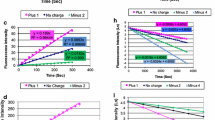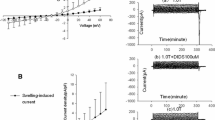Abstract
The influence of cell swelling on cell communication was investigated in cardiomyocytes isolated from the ventricle of adult rats. Measurements of dye coupling were performed in cell pairs using intracellular dialysis of Lucifer Yellow CH. The pipette was attached to one cell of the pair and after a gig ohm seal was achieved, the membrane was ruptured by a brief suction allowing the dye to diffuse from the pipette into the cell. Fluorescence of the dye in the injected as well as in non-dialyzed cell of the pair was continuously monitored. The results indicate that in cell pairs exposed to hypotonic solution the cell volume was increased by about 60% within 35 min and the dye coupling was significantly reduced by cell swelling. Calculation of gap junction permeability (P j) assuming an the intracellular volume accessible to intracellular diffusion of the dye as 12% of total cell volume, showed an average P j value of 0.16 ± 0.04 × 10−4 cm/s (n = 35) in the control and 0.89 ± 1.1 × 10−5 cm (n = 40) for cells exposed to hypotonic solution (P < 0.05). Similar results were found assuming intracellular volumes accessible to the dye of 20 and 30% of total cell volume, respectively. Cell swelling did not change the rate of intracellular diffusion of the dye. The results which indicate that cell volume is an important regulator of gap junction permeability, have important implications to myocardial ischemia and heart failure as well as to heart pharmacology because changes in cell volume caused by drugs and transmitters can impair cell communication with consequent generation of slow conduction and cardiac arrhythmias.





Similar content being viewed by others
References
Kohl P, Nesbitt AD, Cooper PJ, Lei M (2001) Sudden cardiac death by commotion cordis: role of mechano-electric feedback. Cardiovasc Res 50:280–289
van Wagoner DR (1993) Mechanosensitive gating of atrial ATP-sensitive potassium channels. Circ Res 72:973–983
Janse MJ, Coronel R, Wilms FJG, de Groot JR (2003) Mechanical effects on arrhythmogenesis: from pipette to patient. Progress Biophys Mol Biol 82:187–189
De Mello WC, Gonzalez Castillo M, van Loon P (1983) Intercellular diffusion of Lucifer Yell CH in mammalian cardiac fibers. J Mol Cell Cardiol 15:637–645
Veenstra R (2002) Biophysics of gap junction channels. In: De Mello WC, Janse M (eds) Heart cell coupling and impulse propagation in health and disease. Kluwer, Norwell, pp 143–183
De Mello WC, van Loon P (1987) Influence of cyclic nucleotides on junctional permeability in atrial muscle. J Mol Cell Cardiol 19:83–90
De Mello WC (1975) Effect of intracellular injection of calcium on cell communication in heart. J Physiol 250:231–236
Burt JM, Spray DC (1988) Inotropic agents modulate gap junctional conductance between cardiomyocytes. Am J Physiol 254:H1206–H1210
Kleber AG, Riegger CB, Janse MJ (1987) Electrical uncoupling and increase of extracellular resistance after induction of ischemia in isolated, arterially perfused rabbit papillary muscle. Circ Res 61:271–279
De Mello WC (2009) Cell swelling, impulse conduction, and cardiac arrhythmias in the failing heart. Opposite effects of angiotensin II and angiotensin (1–7) on cell volume regulation. Mol Cell Biochem 330:211–217
Powell T, Twist T (1976) A rapid technique for the isolation and purification of adult cardiac muscle cells having respiratory control and a tolerance to calcium. Biochem Biophys Res Commun 72:327–333
Tanigushi Y, Kokubun S, Noma A, Irisawa H (1981) Spontaneously active cells isolated from sinoatrial and atrioventricular node of the rabbit heart. Jpn J Physiol 31:547–558
Boyett MR, Framton JE, Kirby MS (1991) The length, width and volume of isolated rat and ferret ventricular myocytes during twitch contraction and changes in osmotic strength. Exp Physiol 76:259–270
Sorenson AL, Tepper D, Sonnenblick EH et al (1985) Size and shape of enzymatically isolated ventricular myocytes from cardiomyopathic hamsters. Cardiov Res 19:793–799
Imanaga I (1987) Cell-to cell coupling studied by diffusional methods in myocardial cells. Experientia 43:108083
Page E, McCallister LP (1973) Studies on the intercalated disk of rat left ventricular cells. J Ultrastr Res 43:388–411
Matter A (1973) A morphometric study on the nexus of rat cardiac muscle. J Cell Biol 56:690–696
Clemo HF, Stambler BS, Baumgarten CM (1999) Swelling-activated chloride current is persistently activated in ventricular myocytes from dogs with tachycardia-induced congestive heart failure. Circ Res 84:157–165
Mills RW, Narayan SM, Andrew D, McCulloch AD (2008) Mechanisms of conduction slowing during myocardial stretch by ventricular volume loading in the rabbit. Am J Physiol Heart Circ Physiol 295:H1270–H1278
Browe DM, Baumgarten CM (2003) Stretch of beta 1 integrin activates an outwardly rectifying chloride current via FAK and Scr in rabbit ventricular myocytes. J Gen Physiol 122:689–702
Hume JR, Duan D, Collier ML, Yamazaki J et al (2000) Anion transport in heart. Physiol Rev 80:31–81
Wendt-Gallitelli MF, Voigt T, Isenberg G (1993) Microheterogeneity of subsarcolemmal sodium gradients: electron probe microanalysis in guinea pig ventricular myocytes. J Physiol 472:33–34
De Mello WC (1976) Influence of the sodium pump on intercellular communication in heart fibres: effect of intracellular injection of sodium ion on electrical coupling. J Physiol 263:171–197
De Mello WC (1996) Renin angiotensin system and cell communication in the failing heart. Hypertension 27:1267–1272
Sorota S (1995) Tyrosine protein kinase inhibitors prevent activation of cardiac swelling-induced chloride current. Pflügers Arch 431:178–185
De Mello WC (2004) Heart failure: how important is cellular sequestration? The role of the renin angiotensin aldosterone system. J Mol Cell Cardiol 37:431–438
Ismailov II, Benos DJ (1995) Effects of phosphorylation on ion channel function. Kidney Int 48:1167–1179
Laird DW, Puranam KL, Revel JP (1991) Turnover and phosphorylation dynamics of connexin43 gap junction protein in cultured cardiac myocytes. Biochem J 273:67–72
Le Guennec JY, Gannier F, Argibay JA, Garnier D (1991) Stretch-induced increase of resting intracellular calcium concentration in guinea pig ventricular myocytes. Exp Physiol 76:975–978
Jackson P, Strange K (1993) Volume sensitive anion channels mediate swelling activated inositol and taurine efflux. Am J Physiol 265:C1489–C1500
Acknowledgments
This work was supported by Grants GM 61838 and G12RR03051 from NIH.
Author information
Authors and Affiliations
Corresponding author
Rights and permissions
About this article
Cite this article
De Mello, W.C. Cell swelling impairs dye coupling in adult rat ventricular myocytes. Cell volume as a regulator of cell communication. Mol Cell Biochem 343, 107–113 (2010). https://doi.org/10.1007/s11010-010-0504-8
Received:
Accepted:
Published:
Issue Date:
DOI: https://doi.org/10.1007/s11010-010-0504-8




